Description of the effect of patient flow, junior doctor supervision and pandemic preparation on the ability of emergency physicians to provide direct patient care
Andy Lim A B F , Namankit Gupta B , Alvin Lim
A B F , Namankit Gupta B , Alvin Lim  C , Wei Hong
C , Wei Hong  D and Katie Walker
D and Katie Walker  B E
B E
A Department of Emergency Medicine, Monash Medical Centre, 246 Clayton Road, Vic. 3168, Australia.
B School of Clinical Sciences at Monash Health, Monash University, Wellington Road, Clayton, Vic. 3800, Australia. Email: ngup27@student.monash.edu
C Department of Medicine, University of Queensland, St Lucia, Qld 4072, Australia. Email: a.lim.syuen@gmail.com
D Department of Oncology, St Vincent’s Hospital, 41 Victoria Parade, Fitzroy, Vic. 3065, Australia. Email: wei.hong@svha.org.au
E Department of Emergency Medicine, Casey Hospital, 62–70 Kangan Drive, Berwick, Vic. 3806, Australia. Email: katie_walker01@yahoo.com.au
F Corresponding author. Email: andy.lim2@monash.edu
Australian Health Review 44(5) 741-747 https://doi.org/10.1071/AH20180
Submitted: 18 July 2020 Accepted: 10 August 2020 Published: 31 August 2020
Journal Compilation © AHHA 2020 Open Access CC BY
Abstract
Objective A pilot study to: (1) describe the ability of emergency physicians to provide primary consults at an Australian, major metropolitan, adult emergency department (ED) during the COVID-19 pandemic when compared with historical performance; and (2) to identify the effect of system and process factors on productivity.
Methods A retrospective cross-sectional description of shifts worked between 1 and 29 February 2020, while physicians were carrying out their usual supervision, flow and problem-solving duties, as well as undertaking additional COVID-19 preparation, was documented. Effect of supervisory load, years of Australian registration and departmental flow factors were evaluated. Descriptive statistical methods were used and regression analyses were performed.
Results A total of 188 shifts were analysed. Productivity was 4.07 patients per 9.5-h shift (95% CI 3.56–4.58) or 0.43 patients per h, representing a 48.5% reduction from previously published data (P < 0.0001). Working in a shift outside of the resuscitation area or working a day shift was associated with a reduction in individual patient load. There was a 2.2% (95% CI: 1.1–3.4, P < 0.001) decrease in productivity with each year after obtaining Australian medical registration. There was a 10.6% (95% CI: 5.4–15.6, P < 0.001) decrease in productivity for each junior physician supervised. Bed access had no statistically significant effect on productivity.
Conclusions Emergency physicians undertake multiple duties. Their ability to manage their own patients varies depending on multiple ED operational factors, particularly their supervisory load. COVID-19 preparations reduced their ability to see their own patients by half.
What is known about the topic? An understanding of emergency physician productivity is essential in planning clinical operations. Medical productivity, however, is challenging to define, and is controversial to measure. Although baseline data exist, few studies examine the effect of patient flow and supervision requirements on the emergency physician’s ability to perform primary consults. No studies describe these metrics during COVID-19.
What does this paper add? This pilot study provides a novel cross-sectional description of the effect of COVID-19 preparations on the ability of emergency physicians to provide direct patient care. It also examines the effect of selected system and process factors in a physician’s ability to complete primary consults.
What are the implications for practitioners? When managing an emergency medical workforce, the contribution of emergency physicians to the number of patients requiring consults should take into account the high volume of alternative duties required. Increasing alternative duties can decrease primary provider tasks that can be completed. COVID-19 pandemic preparation has significantly reduced the ability of emergency physicians to manage their own patients.
Additional keywords: clinical services, health services management, performance and evaluation, workforce.
Introduction
An understanding of emergency physician (EP) productivity is essential to planning clinical operations.1 Medical productivity, however, is challenging to define, and is controversial to measure.2 EPs in Australian public hospitals supervise junior doctors, manage patient flow, perform administrative duties and teach healthcare students while undertaking clinical shifts.3 Kee et al. has quantified these tasks in the Australian setting,4 and these results are reproduced with permission in Table 1. High workloads are thought to contribute to the very high burnout rates seen in EPs.3 In addition, there is tremendous pressure felt by EPs in most emergency departments (EDs) to also have their own individual patient load, especially if this is considered a primary measure of performance.
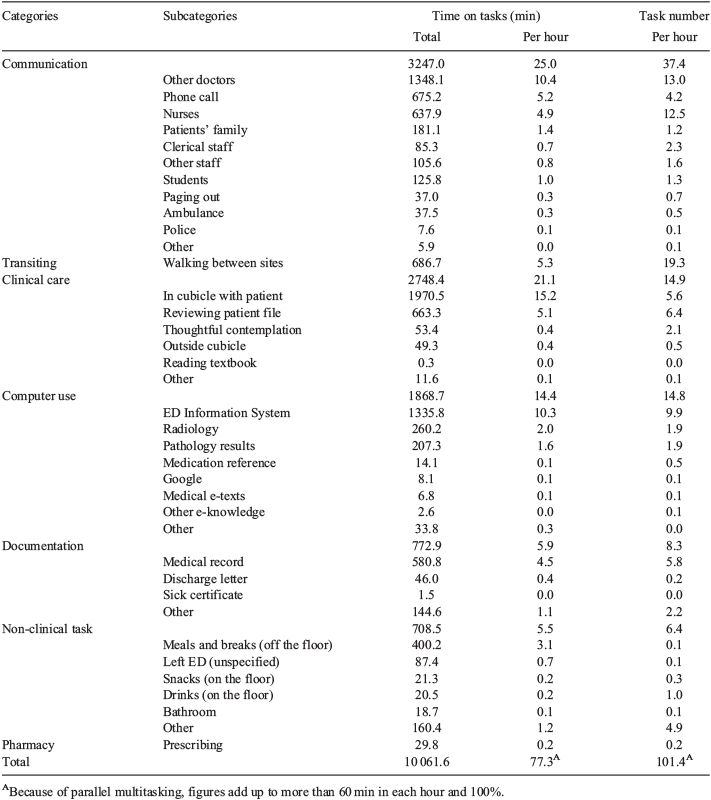
|
Baseline data exist regarding EP productivity in Australia5–7 and internationally;1,8–11 for example, baseline productivity in an Australian private hospital setting has been measured at 1.04 primary consults per h in 2014 (1.32 patients per h total)6 and in a mixed public and private setting at 0.81 primary consults per h in 2015–18 (1.13 patients per h in total).5 A primary consult was when the physician was assigned as the main physician for the patient.5 A secondary consult was a medical triage consultation in advance of another physician who then provides a full consult, or a patient handover.5 The baseline productivity rate for patients has been measured as anywhere from 1.899 to 2.58 patients per h in systems outside of Australia.8–11 It is interesting to note, however, that this figure includes supervised ‘secondary consult’ patients in the patient count. These figures give the administrator a measure of the primary consult output of an EP, but fails to capture all other aspects of productivity.4
Despite these studies, there are no explorations of the relative effects of various system and process factors that may impede EPs’ ability to provide direct patient care. This is even more important given that EPs found that work tasks during February to June 2019 changed dramatically, and were additional to their ongoing usual load.12 Box 1 describes some of these increased duties. To our knowledge, there are no studies that report on the effect of preparing for the COVID-19 pandemic on physician productivity.
| Box 1. Increased duties of emergency physicians during the COVID-19 pandemic12 |
| COVID-19 preparations: |
|
| Communication |
|
| Clinical care |
|
In light of these additional challenges, the present study aims to: (1) describe the ability of EPs to provide primary consults at a metropolitan adult ED during the COVID-19 pandemic when compared with historical performance; and (2) to identify the effect of system and process factors on productivity.
Methods
Study design
This study was a retrospective, cross-sectional, observation of shifts worked by EPs between 1 February and 29 February 2020 at an adult tertiary referral centre in Melbourne. The primary outcome was a description of the mean number of patients seen per hour. The secondary outcome was the identification of significant predictors of productivity when productivity is defined as primary consults per hour. This study was approved by the Monash Human Research Ethics Committee (RES-20–0000–238 L).
Setting
Monash Medical Centre is a 640-bed tertiary teaching hospital that provides a range of surgical, medical, allied health and mental health services. The ED sees ~90 000 presentations annually. The hospital has a large emergency medicine training program and hosts interns, residents, medical students and international medical graduate observers. The adult patients and paediatric patients are seen in separate areas. This study examined the adult ED. Shifts worked are AM (0800 – 1730 hours), PM (1430 – 2400 hours) and midday (1030 – 2000 hours). Areas worked are classified into Acute (resuscitation bays and emergency mental health), Fast Track (ambulant injuries and illnesses), Short Stay Unit (a ward of rapid turnover, uncomplicated admissions) and Main (stretcher-based, complex patients). In-charge shifts involve maintaining overall responsibility for the ED including supervision, teaching and troubleshooting. There were always patients awaiting doctor assessment, so availability of patients to see was not a limiting factor for physician productivity.
Participants
Physicians were included if they were employed as a consultant EP and worked at least one shift in the study period at the study site. Usual work tasks are listed in Table 1. Only primary consults were recorded, so this was chosen as the primary outcome.
Measurements or variables
Productivity was defined as the number of primary consults per hour, measured only if the EP is recorded in the Electronic Medical Record (EMR) as the ‘Treating Physician’. Shift variable data (shift type, shift timing, number of junior doctors supervised and in-charge role) were collected using hospital administrative databases.
Data sources and cleaning
Shifts were recorded on an intention-to-treat principle, so if the physician decided to swap to a different role on the day, this was not captured. Shifts taken as sick leave and personal leave were excluded. Number of years of Australian medical registration was extracted from the publicly available Australia Health Practitioner Regulation Agency database for each EP. Departmental factors (total patient presentations, percentage ED length of stay <4 h, non-admitted length of stay <4 h, admitted length of stay <4 h, admitted non-short stay length of stay <4 h) were generated from the Business Intelligence database for each day studied.
Sample size calculation
Using a population mean of 0.83 patients per h5 × 9.5 h = 7.89 patients per shift and a standard deviaton σ = 1.70 calculated using internal data, the sample size to detect a 10% productivity reduction from this previously published value for α = 0.05 and power = 0.80 was 37 shifts.
Statistical analysis
Descriptive data were reported as percentages or means with interquartile ranges. Change in productivity was compared against the baseline of 0.83 patients per h,5 using a two-tailed, single-sample t-test. Univariate negative binomial regression was used to investigate individual determinants of the model. Statistically significant components (P < 0.05) were included in a multivariate regression model to calculate the direction and magnitude of effects. Effect was reported as exponentiated coefficients with 95% confidence intervals and P values. No missing data were noted for the period studied. Statistical analysis was performed in RStudio v1.2.5033 with base R v3.6.0 (RStudio, Boston, MA, USA). The code written for the study is available on Github (San Francisco, CA, USA).13
Results
Participants
Figure 1 shows the flow of eligibility. A total of 32 EPs were included in the study; 14 (43.8%) were female and 18 (56.3%) were male. Median experience in the Australian system (i.e. years of Australian registration) was 19 years (IQR 12.25–25).
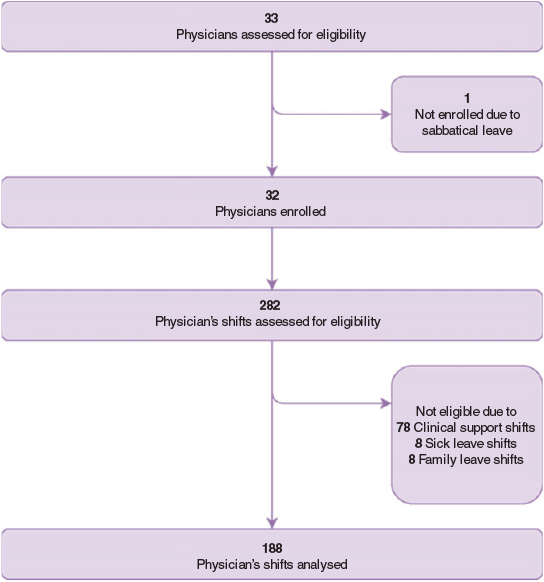
|
Shift and day characteristics
The 32 EPs worked a total of 188 eligible shifts during the study period. The characteristics of these shifts are described in Table 2 and Figure 2. The majority of shifts were worked on weekdays (79.3%), in the Main area (45.7%) and in an in-charge role (83.0%). The AM (50.5%) and PM (47.3%) shift division was roughly equal. The average number of juniors requiring supervision was 2.4. These 188 shifts were worked over a total of 29 days. The characteristics of these days are described in Table 3. Level of bed access during the study period (percentage of non-short stay patients who were admitted to the ward in <4 h) was lower than usual for this site (11%, IQR 7.7–13.8%).
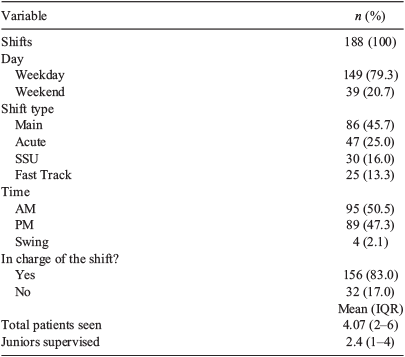
|
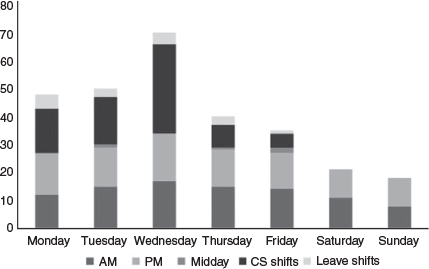
|

|
Key outcomes
The average number of primary patients seen by EPs per shift was 4.07 (95% CI 3.56–4.58), or 0.43 patients per h. This represented a 48.5% reduction in primary consults (3.8 patients per 9.5-h shift or 0.4 patients per h; P < 0.0001). Univariate negative binomial regression was used because the primary outcome measure mean was 4.07 and the variance was 12.7, demonstrating overdispersion. Day of shift, years of registration, shift type, shift time and the number of juniors supervised were included in the final model as these had a statistically significant effect on the primary outcome. Results of these analyses are described in Table 4. Working in a non-resuscitation setting (Fast Track, Main or Short Stay Unit) reduced the number of patients seen. Working a PM or swing shift significantly increased the number of patients seen. There was a 2.2% (95% CI: 1.1–3.4, P < 0.001) decrease in primary patient load with each year of Australian medical registration. This relationship is non-linear, with a steep drop in the first two decades followed by a gradual increase in gradient thereafter. This is described in Figure 3. There was a 10.6% (95% CI: 5.4–15.6, P < 0.001) decrease in primary patient load for each junior that needed to be supervised. This too was non-linear, with peak productivity occurring with one junior supervised. This is described in Figure 4. The volume of patient arrivals and the markers of departmental flow had no statistically significant effect on the productivity of each EP studied.
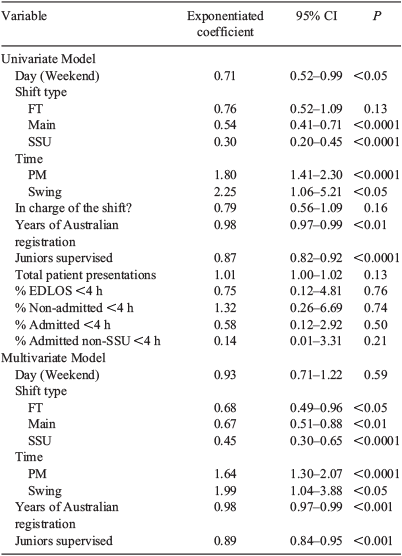
|
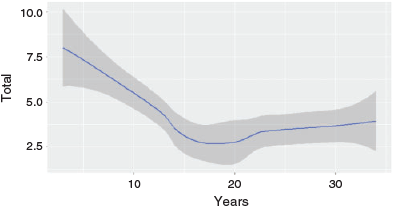
|
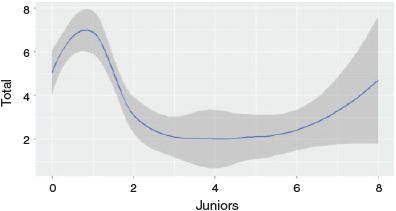
|
Discussion
This retrospective study provides a description of EP productivity in the context of multiple health service challenges. The key findings were: (1) productivity for primary consults dropped by 48.5% to 0.43 patients per h during COVID-19 preparation; (2) ability to provide primary patient care was decreased by working in an area outside of the resuscitation bay, working a day shift, increasing year of Australian medical registration and increasing number of juniors supervised; and (3) departmental flow had no significant effect on number of primary consults.
The productivity rate of 0.43 primary consults per h for this study was below previously reported results.5–8 Australian EP productivity data exists in the literature;5–7 these papers defined ED physician productivity as a count of primary and secondary consults per hour. The hospital studied underwent digital transformation of the entire network’s electronic medical record the year prior, was undergoing renovations at the time and was experiencing the early stage of the COVID-19 pandemic. These factors may have been associated with reduced productivity. Actual non-primary consult productivity is very hard to measure, and this information is not collected routinely in Australia. EPs have very high hourly task rates (up to 101 per h), dominated by communication and clinical activities.4 An increase in non-primary consult activity could explain the 0.43 patient per h result.
Other studies have attempted to build a model to describe emergency doctor productivity changes by the hour.1,14 Joseph et al. characterised the timing of new patient consults across shifts and found that there are predictable attenuations in this rate as the shift progresses for both EPs1 and residents.14 This was regardless of whether there were new patients waiting to be seen.1,14 Our study differed in that it examined the shift as a whole and its macroenvironment rather than providing an hourly description.
Working in the acute setting increased the number of patients seen. These shifts are often worked with only one additional senior doctor to supervise, so this may allow the physician to see more primary consults. Working a swing or PM shift increased the number of patients seen, and this could be due to the known increase in presentation rate in the later stages of the day15 or less alternative duties such as rostering and taking calls from physician’s offices.
Increasing Australian experience reduced patients seen, and this may be the result of taking on a more supervisory role with increasing career time. As this study only measured the number of ‘Treating Clinician’ instances, it did not capture the times that a supervising EP rapidly reviewed a patient at triage, managed a deteriorating patient or provided a second opinion. Experience has been shown to increase hourly work productivity in the ED when measured by Relative Value Units16 or patients per hour,17 but this was United States data from emergency medicine residents (the equivalent to an Australian registrar).16,17 The different doctor seniority and the different primary outcome measure makes this study less comparable with our results.
Increased supervisory loads were associated with decreased primary patient productivity, as this usually means spending more time reviewing patients as secondary consults. This contrasts with the American study that demonstrated that the requirement to supervise one resident (registrar) actually increased the rate of patients seen by the supervising physician (patients per h = 1.99 vs 1.87, P < 0.005).18 This did not change with the level of resident (registrar) experience.18 In contrast, having a medical student to supervise resulted in the same rate of patients per hour as working alone.18 Our study did not measure student supervisory loads.
Finally, although measuring primary productivity is one of a range of management strategies to monitor the health of a service, it is important to understand that the role of leadership in this situation is much broader. The pandemic poses a new situational challenge – technical (which personal protective equipment to use, what process to use to follow up potential exposures, etc.) and adaptive (building a new culture of staff safety, addressing staff concerns and anxieties regarding uncertainty, etc.). Such a problem calls for strong role modelling and for adaptive leadership, a process that mobilises people to address these complexities and thrive.19 EPs are providing value to the health services and system by undertaking this work; this should be understood when interpreting individual patient productivity, which is a unidimensional measure of their performance.
Limitations
The study examined a single centre over an unusual 4 weeks. The shift data were prospectively collected for another purpose, so lacks rigorous verification. The primary outcome (patients per h) is only one aspect of productivity and does not take into account actions that are not recorded in the EMR. EPs have been recorded to perform up to 101 discrete tasks per hour,4 and this aspect of productivity was not captured. Alternative measures such as Relative Value Units or Medicare Benefits Schedule billings generated do not apply in public Australian EDs.
Conclusions
The ability of EPs to provide primary consults at a metropolitan emergency department during COVID-19 preparations was significantly reduced when compared with historical performance. As years of Australian registration progresses, supervisors may take less of a primary provider role and concentrate instead on supervising. Bolstering numbers with junior staff may slightly increase the efficacy of the team, but it comes at an opportunity cost to the supervising EP. These findings are valuable for any healthcare practitioner who influences ED resources.
Competing interests
The authors declare no competing interests.
Acknowledgements
The principal investigator would like to thank the members of the COVID-19 Preparedness Project, a multidisciplinary group of volunteers who offered their skills to prepare health services to forecast demand and assess resources and capabilities. This research did not receive any specific funding.
References
[1] Joseph JW, Davis S, Wilker EH, Wong ML, Litvak O, Traub SJ, Nathanson LA, Sanchez LD. Modelling attending physician productivity in the emergency department: a multicentre study. Emerg Med J 2018; 35 317–22.| Modelling attending physician productivity in the emergency department: a multicentre study.Crossref | GoogleScholarGoogle Scholar | 29545355PubMed |
[2] Schreck DM, Rothman J. The measurement of productivity in an emergency medicine group practice. Ann Emerg Med 2004; 44 S18
| The measurement of productivity in an emergency medicine group practice.Crossref | GoogleScholarGoogle Scholar |
[3] Azan B, Innes ME, Thoma B, Lin M, Van Duyvendyk A, Poonja Z, Chan TM. How I work smarter: a qualitative analysis of emergency physicians’ strategies for clinical and non-clinical productivity. Cureus 2019; 11 e4499
| How I work smarter: a qualitative analysis of emergency physicians’ strategies for clinical and non-clinical productivity.Crossref | GoogleScholarGoogle Scholar | 31249761PubMed |
[4] Kee R, Knott JC, Dreyfus S, Lederman R, Milton S, Joe K. One hundred tasks an hour: an observational study of emergency department consultant activities. Emerg Med Australas 2012; 24 294–302.
| One hundred tasks an hour: an observational study of emergency department consultant activities.Crossref | GoogleScholarGoogle Scholar | 22672170PubMed |
[5] Walker K, Ben-Meir M, Dunlop W, Rosler R, West A, O’Connor G, Chan T, Badcock D, Putland M, Hansen K, Crock C, Liew D, Taylor D, Staples M. Impact of scribes on emergency medicine doctors’ productivity and patient throughput: multicentre randomised trial. BMJ 2019; 364 l121
| Impact of scribes on emergency medicine doctors’ productivity and patient throughput: multicentre randomised trial.Crossref | GoogleScholarGoogle Scholar | 30700408PubMed |
[6] Walker K, Ben-Meir M, O’Mullane P, Phillips D, Staples M. Scribes in an Australian private emergency department: a description of physician productivity. Emerg Med Australas 2014; 26 543–8.
| Scribes in an Australian private emergency department: a description of physician productivity.Crossref | GoogleScholarGoogle Scholar | 25330990PubMed |
[7] Walker KJ, Ben-Meir M, Phillips D, Staples M. Medical scribes in emergency medicine produce financially significant productivity gains for some, but not all emergency physicians. Emerg Med Australas 2016; 28 262–7.
| Medical scribes in emergency medicine produce financially significant productivity gains for some, but not all emergency physicians.Crossref | GoogleScholarGoogle Scholar | 26954293PubMed |
[8] Arya R, Salovich DM, Ohman-Strickland P, Merlin MA. Impact of scribes on performance indicators in the emergency department. Acad Emerg Med 2010; 17 490–4.
| Impact of scribes on performance indicators in the emergency department.Crossref | GoogleScholarGoogle Scholar | 20536801PubMed |
[9] Hess JJ, Wallenstein J, Ackerman JD, Akhter M, Ander D, Keadey MT, Capes JP. Scribe impacts on provider experience, operations, and teaching in an academic emergency medicine practice. West J Emerg Med 2015; 16 602–10.
| Scribe impacts on provider experience, operations, and teaching in an academic emergency medicine practice.Crossref | GoogleScholarGoogle Scholar | 26587079PubMed |
[10] Heaton HA, Nestler DM, Lohse CM, Sadosty AT. Impact of scribes on emergency department patient throughput one year after implementation. Am J Emerg Med 2017; 35 311–4.
| Impact of scribes on emergency department patient throughput one year after implementation.Crossref | GoogleScholarGoogle Scholar | 27856140PubMed |
[11] Shuaib W, Hilmi J, Caballero J, Rashid I, Stanazai H, Tawfeek K, Amari A, Ajanovic A, Moshtaghi A, Khurana A, Hasabo H, Baqais A, Szczerba AJ, Gaeta TJ. Impact of a scribe program on patient throughput, physician productivity, and patient satisfaction in a community-based emergency department. Health Informatics J 2019; 25 216–24.
| Impact of a scribe program on patient throughput, physician productivity, and patient satisfaction in a community-based emergency department.Crossref | GoogleScholarGoogle Scholar | 28438104PubMed |
[12] Walker K. Increased duties of emergency physicians during the COVID-19 pandemic. Melbourne: Monash University; 2020. Available at: https://doi.org/10.26180/5f0960c5d30e5 [verified 14 August 2020].
[13] Lim A. Emergency physician productivity study R code. San Francisco: Github; 2020. Available at: https://github.com/asel0211/EPhysicianProductivity [verified 14 August 2020].
[14] Joseph JW, Henning DJ, Strouse CS, Chiu DT, Nathanson LA, Sanchez LD. Modeling hourly resident productivity in the emergency department. Ann Emerg Med 2017; 70 185–90.e6.
| Modeling hourly resident productivity in the emergency department.Crossref | GoogleScholarGoogle Scholar | 28110994PubMed |
[15] Lim A, Barua R, Hong W, Lim A. Using the national time presentation curve to guide staffing. Emerg Med Australas 2020; 32 532–33.
| Using the national time presentation curve to guide staffing.Crossref | GoogleScholarGoogle Scholar | 32279442PubMed |
[16] Brennan DF, Silvestri S, Sun JY, Papa L. Progression of emergency medicine resident productivity. Acad Emerg Med 2007; 14 790–4.
| Progression of emergency medicine resident productivity.Crossref | GoogleScholarGoogle Scholar | 17726123PubMed |
[17] Dowd MD, Tarantino C, Barnett TM, Fitzmaurice L, Knapp JF. Resident efficiency in a pediatric emergency department. Acad Emerg Med 2005; 12 1240–4.
| Resident efficiency in a pediatric emergency department.Crossref | GoogleScholarGoogle Scholar | 16293898PubMed |
[18] Bhat R, Dubin J, Maloy K. Impact of learners on emergency medicine attending physician productivity. West J Emerg Med 2014; 15 41–4.
| Impact of learners on emergency medicine attending physician productivity.Crossref | GoogleScholarGoogle Scholar | 24578767PubMed |
[19] Heifetz RA, Heifetz R. Leadership without easy answers. Cambridge: Harvard University Press; 1994.


